|
|
|
Sort Order |
|
|
|
Items / Page
|
|
|
|
|
|
|
| Srl | Item |
| 1 |
ID:
084034
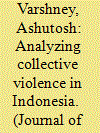

|
|
|
| 2 |
ID:
133716
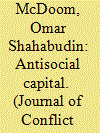

|
|
|
|
|
| Publication |
2014.
|
| Summary/Abstract |
Although popularly perceived as a positive force important for objectives such as economic development and democracy, social capital may also be linked to less desirable outcomes. This article highlights a dark side to social capital by pointing to its role in a particularly pernicious phenomenon: genocidal violence. Drawing on a survey of residents from one community that experienced violence during Rwanda's 1994 genocide, I show that individual participation in the violence was partly determined by the features of residents' social networks. Perpetrators possessed larger networks in general and more connections to other perpetrators in particular. The quality as well as quantity of connections also mattered. Strong ties generally, and kinship and neighborly ties specifically, were strong predictors of participation. In contrast, possession of countervailing ties to nonparticipants did not reduce a resident's likelihood of participation. Drawing on in-depth interviews to explore the possible mechanisms behind these findings, I suggest participants' networks fulfilled functions of information diffusion, social influence, and behavioral regulation. More broadly, the findings suggest the importance of social structure and social interaction for participation in collective violence. Relational data should complement individual attribute data in predicting participation. The findings also suggest, contrary to the neo-Malthusian interpretation, that the role played by Rwanda's extraordinarily high population density in the violence may have been more sociological than ecological in origin. The diffusion, influence, and regulatory effects of social connections are likely to be amplified in communities where individuals live in close spatial proximity to each other.
|
|
|
|
|
|
|
|
|
|
|
|
|
|
|
|
| 3 |
ID:
090904
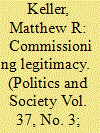

|
|
|
|
|
| Publication |
2009.
|
| Summary/Abstract |
Based on an analysis of the reports of twenty-eight national-level public commission inquiries into events involving ethno-national violence-drawn from five national contexts and arrayed over the course of the twentieth century-this article demonstrates the strikingly transnational character of these investigatory bodies' attempts to authoritatively explain episodes of collective violence and to thereby restore governing legitimacy in the wake of violent crises. One of four distinct "logics," or core explanatory frameworks, each associated with a particular mode of "racial power," characterized a diverse cross-national pool of violence commission reports during defined periods of the twentieth century. In revealing globally encompassing logics to what has often been framed as a national or case-specific phenomenon, the author shows how global ideational currents compose a key dimension of national political dynamics.
|
|
|
|
|
|
|
|
|
|
|
|
|
|
|
|
| 4 |
ID:
111586
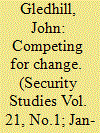

|
|
|
|
|
| Publication |
2012.
|
| Summary/Abstract |
When collective violence breaks out during periods of regime change, the root cause of that violence is ordinarily assumed to be a failure of state and/or governmental organizations, alongside transition. However, there are limits to the applicability of this understanding, since violence sometimes erupts during regime change, even when state and executive organs remain intact. This paper addresses those puzzling cases, by arguing that transitional violence can be a by-product of competition between, or within, a state's security services-for power and resources in an emerging regime. Competition develops where there is intense uncertainty about the form that the new regime might take and associated uncertainty about the distribution of power and state funds among state security services within that regime. The dynamics of transitional violence through intrastate competition are illustrated in the paper through treatment of two "most different" cases: Indonesia (1998) and Romania (1990).
|
|
|
|
|
|
|
|
|
|
|
|
|
|
|
|
| 5 |
ID:
084035
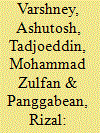

|
|
|
|
|
| Publication |
2008.
|
| Summary/Abstract |
Indonesia has witnessed explosive group violence in recent years, but unlike its plentiful economic statistics, the data on conflict are remarkably sketchy. Because the New Order (1966-1998) wanted to give the appearance of order and stability, it did not believe in publishing reports on group conflict, nor did it allow researchers and nongovernmental organizations to probe the patterns and causes of conflict. This article is based on the first multiyear dataset ever constructed on group violence in Indonesia. Following, and adapting for Indonesian conditions, methodologies developed and used elsewhere, we cover the years 1990-2003, split the data into various categories, and identify the national, regional, and local patterns of collective violence. Much that we find is surprising, given the existing theories and common perceptions about violence in Indonesia. Of the several conclusions we draw, the most important one is that group violence in Indonesia is highly locally concentrated. Fifteen districts and cities (kabupaten and kota), in which a mere 6.5 percent of the country's population lived in 2000, account for as much as 85.5 percent of all deaths in group violence. Large-scale group violence is not as widespread as is normally believed. If we can figure out why so many districts remained reasonably quiet, even as the violent systemic shifts-such as the decline of the New Order-deeply shook fifteen districts causing a large number of deaths, it will advance our understanding of the causes of collective violence in Indonesia.
|
|
|
|
|
|
|
|
|
|
|
|
|
|
|
|
| 6 |
ID:
148227
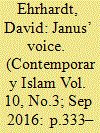

|
|
|
|
|
| Summary/Abstract |
This article analyses the role of religious leaders in collective violence in Kano, the major urban centre in northern Nigeria. It compares two episodes of collective action in the city—the violent ‘Plateau riots’ in 2004 and the non-violent ‘cartoon protests’ in 2006—to explore the role of religious leaders in the variation in violence between the two events. The core argument is that the ways in which Islamic and Christian preachers framed the triggering events for these cases facilitated different forms of mobilisation and enemy identification in response. In 2004, the interpretation of violence in Plateau State through the ‘Christians-versus-Muslims’ frame allowed for mobilisation within Kano’s Christian and Muslim communities as well as for the identification of local Christians as enemies. In 2006, in contrast, the infamous Danish cartoons were actively framed as part of the global struggle between faithful Nigerians and nonreligious Westerners, facilitating non-violent mobilisation across Christian-Muslim boundaries. Thus, the divergent discursive strategies employed by religious leaders are likely to have contributed to violent escalation in 2004 and to peaceful mobilisation in 2006. At the same time, however, the article emphasises the interaction of discursive framing with other factors, such as the role of security forces and the inextricable connections between religious and political authorities in Kano. The article is based on mixed-methods data collected in Kano between 2006 and 2012, including perceptions survey data, semi-structured interviews, and newspaper articles.
|
|
|
|
|
|
|
|
|
|
|
|
|
|
|
|
| 7 |
ID:
133701


|
|
|
|
|
| Publication |
2014.
|
| Summary/Abstract |
Common notions about the source of communal land conflict in Africa have long explained it as growing out of conditions of environmental scarcity. This article argues instead that the institutional structure of the legal system is central to understanding which countries are prone to experience communal land conflict. When competing customary and modern jurisdictions coexist in countries inhabited by mixed identity groups, the conflicting sources of legal authority lead to insecurity about which source of law will prevail. Because the source of law is contested, conflict parties cannot trust the legal system to predictably adjudicate disputes, which encourages the use of extrajudicial vigilante measures. Using new data on communal violence in West Africa, this argument is examined for the period 1990-2009. The results show that in countries where competing jurisdictions exist, communal land conflict is 200-350% more likely. These findings suggest that researchers should consider the role of legal institutions and processes in relation to social unrest and collective violence
|
|
|
|
|
|
|
|
|
|
|
|
|
|
|
|
| 8 |
ID:
103124
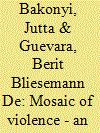

|
|
|
| 9 |
ID:
144930
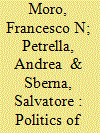

|
|
|
|
|
| Summary/Abstract |
Violence perpetrated by organized crime nowadays represents a major threat to state stability, both because it directly challenges political institutions, targeting officials and using terrorist techniques, and because severe inter-group conflict strongly affects human security. Though it is a distinctive feature of illegal markets and a constant strategy of Mafia-like groups, the occurrence of violence is localized in time and space. The article aims to explain temporal and spatial variation in Mafia killings focusing on its political determinants, as organized crime is deeply embedded in the political system. The analysis shows that there is a clear link between the structure of the political markets and the severity of violence. In particular, the fragmentation of the political market is negatively associated with the strategy of criminal groups to exploit violence. By contrast, single-party dominance and bipartisanship lead to an increase in homicides since these organizations have few opportunities to access the political arena. Outcomes are assessed through the analysis of monthly homicides reported by police forces in Italian provinces from 1983 to 2008.
|
|
|
|
|
|
|
|
|
|
|
|
|
|
|
|
| 10 |
ID:
178680
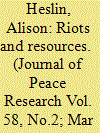

|
|
|
|
|
| Summary/Abstract |
How does food access affect the mobilization of collective violence? The upsurge in rioting in 2008 drew broad attention to the relationship of food and conflict, as scholars and policymakers sought to understand the mobilization and variation of rioting events. Studies have shown a robust relationship between conflict and food prices, noting an increase in incidents of violent conflict during times of high global prices. This study furthers the theory on the role of food access in riot mobilization, investigating the mechanisms by which changes in food access translate into collective violence. Using detailed, first-hand accounts of rioting in 2007 and 2008, this study investigates the motives and grievances of the community members where riots occurred and the relationship of those grievances to food access, while contrasting these accounts to communities that did not engage in rioting. In the cases presented, a change in food access motivated protest and violence involving existing grievances rather than explicitly addressing food access. In this way, food changed the meaning and severity of existing grievances. The cases studied add to our understanding of concurrent upsurges in food riots by outlining the ways that food access interacts with local contexts to initiate violent conflict, stressing the presence of existing actors who use decreased food access to mobilize resources to address existing grievances. While media accounts highlighted food access as the primary concern of food rioters, this study argues that many ‘food riots’ were not, in fact, directly motivated by food access. Rather, changes to food access can aid in mobilizing protests around a range of grievances, some unrelated to food access. Efforts to address the causes of food-related instability will be unsuccessful if they focus solely on food access without addressing the primary motivating grievance and understanding how food access relates to that grievance.
|
|
|
|
|
|
|
|
|
|
|
|
|
|
|
|
| 11 |
ID:
155199
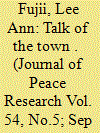

|
|
|
|
|
| Summary/Abstract |
How do people come to participate in violent display? By ‘violent display’, I mean a collective effort to stage violence for people to see, notice, or take in. Violent displays occur in diverse contexts and involve a range of actors: state and non-state, men and women, adults and children. The puzzle is why they occur at all given the risks and costs. Socialization helps to resolve this puzzle by showing how actors who have consciously adopted or internalized group norms might take part, despite the risks. Socialization is more limited in explaining how and why actors who are not bound by group norms also manage to put violence on display. To account for these other pathways, I propose a theory of ‘casting’. Casting is the process by which actors take on roles and roles take on actors. Roles enable actors to do things they would not normally do. They give the display its form, content, and meaning. Paying attention to this process reveals how violent displays come into being and how the most eager actors as well as unwitting and unwilling participants come to take part in these grisly shows. To explore variation in the casting process, I investigate violent displays that occurred in two different contexts: the Bosnian war and Jim Crow Maryland. Data come from interviews, trial testimonies, and primary sources.
|
|
|
|
|
|
|
|
|
|
|
|
|
|
|
|
| 12 |
ID:
153179
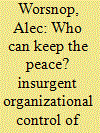

|
|
|
|
|
| Summary/Abstract |
Every armed organization seeks the ability to turn violence on and off by getting fighters to fight when ordered and to stop fighting when similarly ordered. This ability is a defining feature of what makes organized violence, in fact, organized. While state militaries develop clear hierarchies and disciplinary procedures to accomplish this goal, the complexity of civil war makes the task more difficult for insurgent groups. I argue that the leaders of insurgent organizations are able to turn violence on and off when they have deliberately established resource control through the direct, and exclusive, distribution of resources to their followers and those followers are socially embedded, meaning that members are united by strong horizontal ties and group norms. In contrast to existing approaches, I argue that material and social endowments do not predetermine whether leaders can establish resource control or embeddedness. Further, laying out the precise organizational mechanisms that determine when organizations can turn violence on and off challenges the utility of conceptions such as “fragmentation” or “cohesion” for explaining insurgent behavior and conflict outcomes. I test the theory by examining variation in behavior over time in two organizations facing different structural contexts—Jaysh al-Mahdi in Iraq and the Viet Minh in Vietnam—and find strong support for my argument while casting doubt on existing explanations.
|
|
|
|
|
|
|
|
|
|
|
|
|
|
|
|
|
|
|
|
|